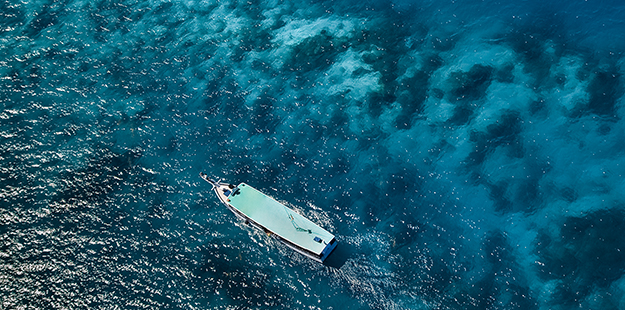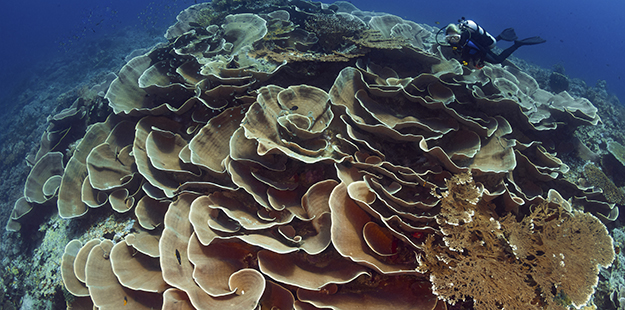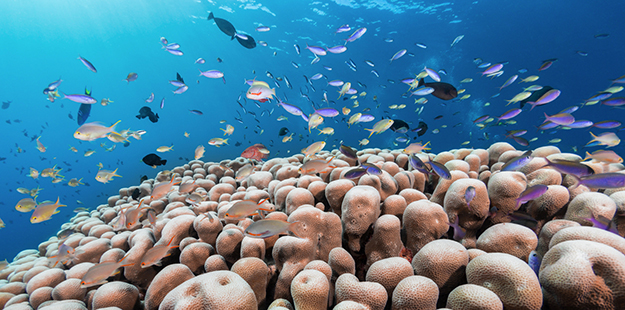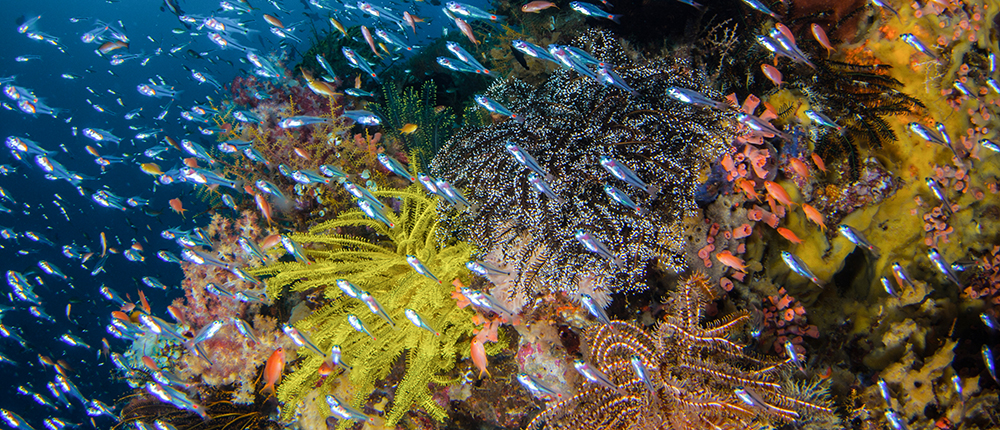When in Roma
A virtual visit to a favorite Wakatobi dive site
There are more than 40 dive sites that lie within Wakatobi Resort’s private marine preserve, offering everything from snorkel-friendly shallows to plunging walls and dramatic fish-covered sea mounts. Each visitor to the preserve has their own favorites, but there are certain sites that remain the most-requested favorites. One of these is Roma, and to learn why, we invite you to join us on a virtual tour of this always-memorable underwater formation.

On the way to Roma you’ll cruise along a colorful reef line that transitions from the shallows to deep blue water. Photo by Didi Lotze
A visit to Roma begins with a relaxing 20-minute boat ride from the resort. Along the way, your dive boat will cruise the edge of a reef line that creates a dramatic transition from colorful shallows to deep blue water. As you approach, the upper outlines of the seamount known as Roma are clearly visible in the water. At low tide, the top of this formation sits just three meters below the surface. That’s good news for the snorkelers who are sharing the boat with your dive group, as they will have plenty to explore on the broad upper areas of the site.
For a preview of diving Roma, watch this short video.
But the shallows can wait, because based on the plan you and your dive guide discussed, you’ll start your explorations at the deep end. Beginning the descent, you are soon immersed in a large school of blackfin and bigeye barracuda, which then gives way to a swarm of snapper and jack crevalle.

At Roma it’s not uncommon for large groups of jack crevalle to circle around as you make your way along the reef. Photo by Walt Stearns
At the 20-meter/65 foot mark, the site’s prolific coral colonies share space with a grove of large barrel sponges. As you descend a little further, you catch a glimpse of Roma’s signature feature. Spreading over the slope is a large, circular colony of turbinaria coral, some 20 feet across. When seen from above, the sculpted leaf-like folds of the formation combine to create the impression of a giant rose flower.

Seen from above Roma’s large colony of turbinaria coral, some 20 feet across, resembles a giant rose. Photo by Walt Stearns
After snapping some photos, it’s time to start a slow ascent. Looking back up the ridge, the water reveals the distinctly different sides of the seamount. To the left, the pinnacle becomes an almost vertical wall that is covered in a dense mixture of hard corals and sponges. Crinoids perch on the outer edges of branching corals, extending frilly, multi-hued tentacles to catch passing morsels brought by the gentle current. Less obvious is the crocodile fish that has staked out an ideal ambush point on the edge of an outcropping. It remains motionless, seemingly indifferent to your presence as you move closer to capture an image of its signature eyelashes.
The vistas are dramatic, but equally interesting is the opposite side of the mount, which has a gentler slope that contains stands of pavona coral and clumps of colorful sponges, all interspersed between patches of white sand. The lettuce-like arms of the corals provide shelter for a variety of small reef fish such as anthias, redtooth triggerfish, fusiliers and convict blennies. You keep an eye out for cuttlefish and octopus, which are found on this site with predictable regularity. A closer look reveals multi-hued nudibranchs engaged in their slow, slithering marches, and banded sea snakes weaving through this living maze. And all the activity isn’t just in the corals, as there are mantis shrimp and yellow-banded jawfish excavating burrows in the sand patches in between. A wave from your dive guide brings you to a prominent sea fan. At first, you see nothing, then the profile of a pygmy seahorse comes into focus.

Potato corals toward the top of Roma’s pinnacle provide refuge for colorful anthias. Photo by Marco Fierli, marcof8.com
A slow but steady ascent finally brings you to the top of the pinnacle, where you linger at depths normally reserved for a safety stop. Here, there is a broad swath of potato coral that attracts an assortment of damselfish, anthias and pygmy angels. The play of sunlight on the corals and swirling mass of life is mesmerizing, making it easy to loose any sense of time. A glance at your dive computer tells you that it’s been almost 75 minutes since you entered the water to discover Roma. All things must come to an end, but this is one dive that will stay with you for a long time to come.
Roma is just one of many memorable underwater experiences that await at Wakatobi Resort. We would love to show you all of our underwater treasures, and host you with warm Indonesian hospitality, gourmet meals and casual luxury.
Contact us at office@wakatobi.com, or complete a quick trip inquiry at wakatobi.com.
Visit us on Facebook.


